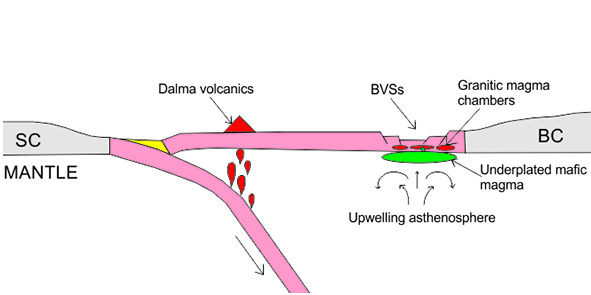Late Paleoproterozoic bimodal magmatic rocks in the Nimchak Granite Pluton of the Bathani volcano-sedimentary sequence, Eastern India: implications for the Columbia supercontinent formation with respect to the Indian landmass
DOI:
https://doi.org/10.13133/2239-1002/16978Keywords:
Central Indian Tectonic Zone, Singhbhum Craton, Bundelkhand Craton, Dalma Volcanic Belt, Nimchak Granite Pluton, island arc systemAbstract
The Nimchak Granite Pluton occurs within the Bathani volcano-sedimentary sequence (BVSs) that was punctured by several mafic/dolerite dykes during its evolution. The BVSs is positioned in the northernmost part of the Chotanagpur Granite Gneiss Complex (CGGC), Eastern India. Two mafic dykes are preserved in the pluton that were emplaced after the entire felsic magma chamber had solidified. The present work discusses geochemical signatures of mafic rocks from the two well-preserved dolerite dykes and felsic rocks from the host pluton. The mafic and felsic rocks display high LILE/HFSE and LREE/HREE ratios, which are distinctive features of magmas generated in subduction zones. Tectonic discrimination diagrams clearly suggest that the mafic-felsic rocks were generated in a subduction zone tectonic setting with the mafic rocks clearly plotting in the region of ‘back-arc basin basalt’. The felsic rocks of the Nimchak Pluton give Th–U–Pb monazite chemical age of 1768 Ma for their emplacement. This particular magmatic event is correlatable to the global phenomenon of the Columbia supercontinent formation. Results presented in this work suggest that the CGGC represents an island arc setting in which the Dalma Volcanic Belt (DVB) constitutes the volcanic arc, while the BVSs constitutes the back-arc rift. The DVB is an arcuate belt of volcanic rocks situated to the south of CGGC. Northward subduction of the southern Singhbhum block underneath the northern Bundelkhand block during the Proterozoic produced the island arc system. The crustal plates involved in this subduction were oceanic plates that were attached to the Singhbhum and Bundelkhand cratons.

Downloads
Published
Issue
Section
License
Copyright (c) 2022 Bibhuti Gogoi

This work is licensed under a Creative Commons Attribution 4.0 International License.

